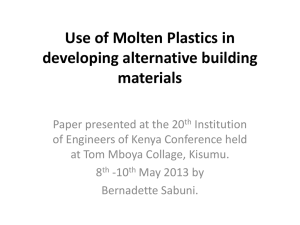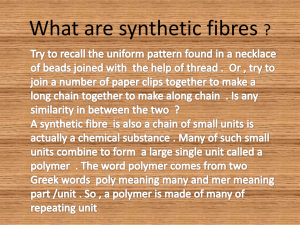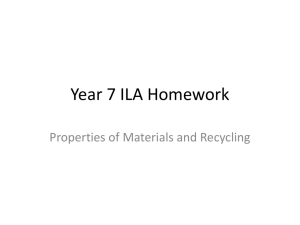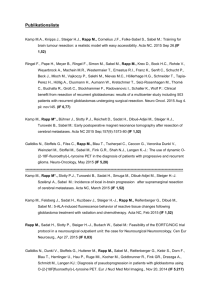RAPP - Chenango County Government
advertisement
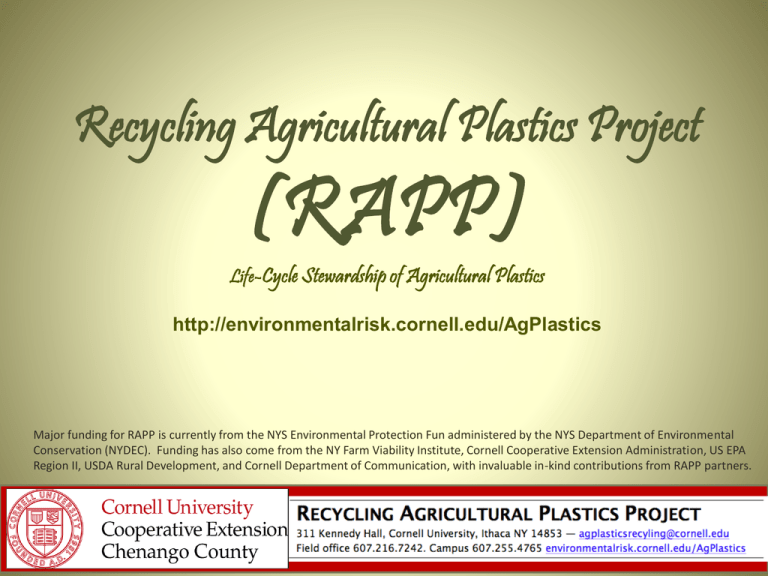
Recycling Agricultural Plastics Project (RAPP) Life-Cycle Stewardship of Agricultural Plastics http://environmentalrisk.cornell.edu/AgPlastics Major funding for RAPP is currently from the NYS Environmental Protection Fun administered by the NYS Department of Environmental Conservation (NYDEC). Funding has also come from the NY Farm Viability Institute, Cornell Cooperative Extension Administration, US EPA Region II, USDA Rural Development, and Cornell Department of Communication, with invaluable in-kind contributions from RAPP partners. Chenango County Farms • over 70 dairy farms • average plastic wrap weighs 3 - 3.5 lbs. • Smaller farms produce > 1,000 lbs. agricultural plastics/year Note: larger farms using more plastic would produce more What falls under the agricultural plastics umbrella? • bale wrap • • silage and grain bags • • bunker silo covers • bale netting • • Polytwine • feed and pellet bags • • irrigation • tubing • • drip tape • maple tubing • green and hoophouse covers nursery pots and seedling trays mulch and fumigation films Tarps Netting rigid containers bee hive frames Why is Ag Plastics Recycling Different? Photos: Lois Levitan, RAPP Most plastics from farms are dirty, bulky, dispersed across a rural landscape and may have residues What is the Recycling Agricultural Plastics Project (RAPP)? RAPP is a program based at Cornell University which works with local CCE educators to aid in the proper recycling of agricultural plastics What is the Recycling Agricultural Plastics Project (RAPP)? Photo from: The Post Standard Since 2009, RAPP has coordinated the collection of nearly 1 million pounds of used plastic that would otherwise be sent to landfills, burned in open fires on farms or left behind in the fields. What is the Recycling Agricultural Plastics Project (RAPP)? North Brook Farms, Inc Baleboard® RAPP currently collaborates with numerous agencies, organizations, businesses and farmers across NY to recycle plastics into sidewalk pavers, plastic lumber, oil and other products! How NYS Ag Plastics Recycling Works • RAPP, CCE, SWCD, waste managements and other recycling agencies and businesses work together to help spread the recycling message, teach best management practices and carry out the collection of the plastic • With farm staff assisting with loading the baler and RAPP operating it, 1000 pounds of film can be compacted into a bale in about 30 minuets. • Finished bales are accumulated locally and then move to market Ag Plastics Recycling with RAPP What RAPP Does On-farm education: preparing plastic for recycling, incorporating recycling into farm routine, operating compaction equipment Encourage behavior change: STOP on-farm disposal START recycling Extended producer: responsibility among agricultural plastic manufacturers & distributors Develop infrastructure: Streamline logistics of moving from farms to new end products. Cultivate market options appropriate for agricultural plastics feedstock Levitan, Lois, Cornell University 2012 On the Farm Education • Preparing plastic for recycling (BMP) • Incorporating recycling into the farm routine – Lets make this more of a habit than a hassle • Operate compaction equipment Promote Recycling (end on-farm disposal) • Open burning restrictions strong motivator to recycle – Almost impossible to enforce on 2 million farms across the US • A change in ‘Cultural climate’ – Recycling is less hassle and a lower cost than alternatives • Seeing is believing – People what to know where the plastic goes and what it becomes BMP Keep plastic dry and shake out any pebbles/clumps Roll or fold the plastic into 3’x 3’ pillows or bundles Store the plastic off the ground, out of mud, gravel and grit Separate different types of plastic by color and type What I Have been asked to do as a RAPP educator • Act as an outreach to farms that wish to participate and find farms that produce ag plastics throughout the county • Educate individual farms about the BMPs and what happens to the recycled plastics and develop a BMP for their individual farm Photo courtesy of Cornell RAPP What I Have been asked to do as a RAPP educator • Find the location and demographics of farming in Chenango and Broome Counties –Type of agriculture, location, amount of plastic used What I Have been asked to do as a RAPP educator • Identify events where a RAPP display would be appropriate and effective • Identify and post RAPP publicity materials • Identify and outreach to our target audience through local news Photo courtesy of Cornell RAPP What I Have been asked to do as a RAPP educator • identify good locations for storage of finished bales – places where farmers can easily bring the bales but where dumping of junk plastic would be difficult. How you can help • Talk about the program to people you know and meet • Recruit participants • Distribute update fliers • Make connections What you need to know • • • • RAPP offers an alternative RAPP can help recycle agricultural plastics Each farm needs its own BMP to be successful Bigfoot Baler in action http://www.syracuse.com/news/index.ssf/2012/07/ recycling_of_agricultural_plas.html Your Local Contact Emily Jane Anderson Chenango County CCE 99 North Broad Street Norwich, NY 13815 607-334-5841 ex. 17 eja74@cornell.edu

